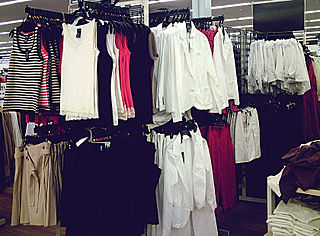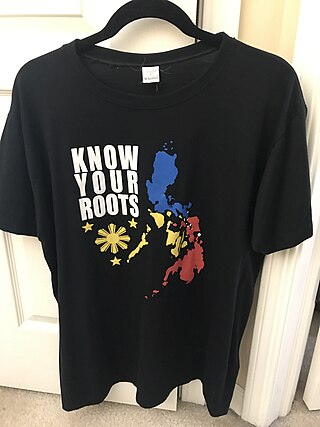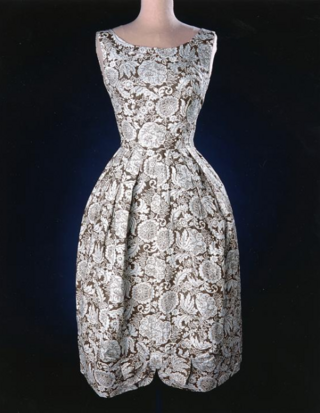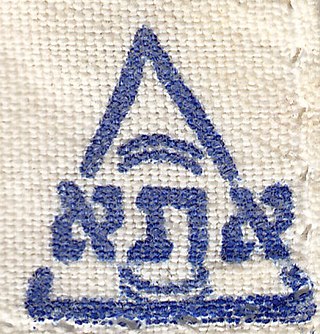
Ready-to-wear (RTW) – also called prêt-à-porter, or off-the-rack or off-the-peg in casual use – is the term for garments sold in finished condition in standardized sizes, as distinct from made-to-measure or bespoke clothing tailored to a particular person's frame. In other words, it is a piece of clothing that was mass produced in different sizes and sold that way instead of it being designed and sewn for one person. The term off-the-peg is sometimes used for items other than clothing, such as handbags. It is the opposite of haute couture.

Overalls or bib-and-brace overalls, also called dungarees in British English, are a type of garment usually used as protective clothing when working. The garments are commonly referred to as a "pair of overalls" by analogy with "pair of trousers".

James Alexander Reed was an American Democratic Party politician from Missouri.

Alpha Industries is an American clothing manufacturer founded in 1959 in Knoxville, Tennessee. Alpha Industries specializes in American military style and fashion apparel items such as flight jackets. It has produced the M65 Jacket for the US military for over half a century.

Viyella is a blend of wool and cotton first woven in 1893 in England, and the "first branded fabric in the world". It was made of 55% merino wool and 45% cotton in a twill weave, developed by James and Robert Sissons of William Hollins & Co, spinners and hosiers. The brand name, first registered as a trademark in 1894, and registered in the United States in 1907, soon covered not only the original fabric, to be sold by the yard, but also clothing. At first this was made by separate businesses, but it was not long before Hollins started producing their own clothes and offering franchises to manufacturers who would use the Viyella label. Following increasing emphasis on garment manufacture over the years, Viyella is now a fashion brand for clothes and home furnishings made of a variety of fabrics. The original wool/cotton blend is no longer sold.

Fast fashion is the business model of replicating recent catwalk trends and high-fashion designs, mass-producing them at a low cost, and bringing them to retail quickly while demand is at its highest. The term fast fashion is also used generically to describe the products of this business model, particularly clothing and footwear. Retailers who employ the fast fashion strategy include Primark, H&M, Shein, and Zara, all of which have become large multinationals by driving high turnover of inexpensive seasonal and trendy clothing that appeals to fashion-conscious consumers.
The study of the history of clothing and textiles traces the development, use, and availability of clothing and textiles over human history. Clothing and textiles reflect the materials and technologies available in different civilizations at different times. The variety and distribution of clothing and textiles within a society reveal social customs and culture.

Shaxi is a town under the administration of the prefecture-level city of Zhongshan in Guangdong Province, China, located to the west of downtown Zhongshan. The township covers an area of 55 km2 (21 sq mi) and has a population of 162,000, including 100,000 migrant workers. It is administered by 15 neighborhoods and one community committee (社区).

Fashion design is the art of applying design, aesthetics, clothing construction and natural beauty to clothing and its accessories. It is influenced by culture and different trends, and has varied over time and place. "A fashion designer creates clothing, including dresses, suits, pants, and skirts, and accessories like shoes and handbags, for consumers. He or she can specialize in clothing, accessory, or jewelry design, or may work in more than one of these areas."

Sustainable fashion is a term describing efforts within the fashion industry to reduce its environmental impacts, protect workers producing garments, and uphold animal welfare. Sustainability in fashion encompasses a wide range of factors, including cutting CO2 emissions, addressing overproduction, reducing pollution and waste, supporting biodiversity, and ensuring that garment workers are paid a fair wage and have safe working conditions.

The textile and clothing industries provide a single source of growth in Bangladesh's rapidly developing economy. Exports of textiles and garments are the principal source of foreign exchange earnings. By 2002 exports of textiles, clothing, and ready-made garments (RMG) accounted for 77% of Bangladesh's total merchandise exports. Emerging as the world's second-largest exporter of ready-made garment (RMG) products, Bangladesh significantly bolstered employment within the manufacturing sector.

Paper clothing is garments and accessories made from paper or paper substitutes.

The Kansas City Garment District Museum is located in the Garment District, in the lobby of DST Systems Inc.'s Poindexter Building. It is a part of the Kansas City Museum.

A house dress is a type of simple dress worn informally at home for household chores or for quick errands. The term originated in the late nineteenth century to describe at-home garments designed for maximum practicality and usually made from washable fabrics. It is directly descended from the Mother Hubbard dress. House dresses are also known as dusters in American and Philippine English, a term which also encompasses the muumuu. Such dresses were a necessary part of the housewife's wardrobe in the early twentieth century and could be widely purchased through mail-order catalogues. The house dress remains a contemporary and frequently worn garment in some parts of the world.

Israeli fashion refers to fashion design and modeling in Israel.

Clothing industry or garment industry summarizes the types of trade and industry along the production and value chain of clothing and garments, starting with the textile industry, embellishment using embroidery, via the fashion industry to apparel retailers up to trade with second-hand clothes and textile recycling. The producing sectors build upon a wealth of clothing technology some of which, like the loom, the cotton gin, and the sewing machine heralded industrialization not only of the previous textile manufacturing practices. Clothing industries are also known as allied industries, fashion industries, garment industries, or soft goods industries.

Nell Donnelly Reed was an American fashion designer and businesswoman, known for her house dresses, who founded the Nelly Don brand.

Fashion and clothing for Filipino-Americans has been a symbol of political action since their arrival to the U.S. in the early 20th century. Dealing with U.S. occupation in the Philippines, both students and laborers adopted American styles of dress while also maintaining styles of dress that originated in the Philippines. Fashion remains an integral aspect for the Filipino-American community, with many cultural celebrations regarding fashion such as Canada Philippine Fashion Week in Toronto and other fashion weeks occurring in numerous global cities. Aside from partaking in fashion, the Philippines also produces clothing that is made for mass consumption overseas, in places such as the U.S., Europe, and Canada.

Feed sack dresses, flour sack dresses, or feedsack dresses were a common article of clothing in rural US and Canadian communities from the late 19th century through the mid 20th century. They were made at home, usually by women, using the cotton sacks in which flour, sugar, animal feed, seeds, and other commodities were packaged, shipped, and sold. They became an iconic part of rural life from the 1920s through the Great Depression, World War II, and post-World War II years.

ATA Textile Company Ltd. was one of the first industrial enterprises founded in Israel, established in 1934. It was the first company in Israel to manufacture and design textiles locally. The textile factory continued to grow until the 1970s, and closed in 1985. ATA was re-established as a fashion brand in 2016 and is now based in Tel Aviv.




















